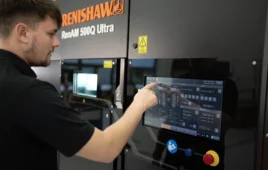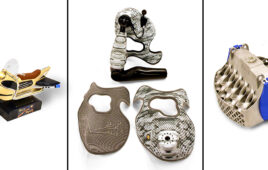The Covid-19 pandemic brought considerable attention to the 3D printing/additive manufacturing industry. Much of it focused on systems that work with polymer and resin materials. But what about metal additive manufacturing? How has the pandemic affected the metal side of additive manufacturing? Kevin Brigden, additive manufacturing applications engineer at Renishaw, addressed this and other developments in metal AM.
Even though the pandemic has spotlighted additive manufacturing with polymers in the form of face masks and shields, metal additive manufacturing has played a role, just one that was not as obvious.
“Where you will find metal is in supporting strategies, such as fixturing and tooling,” said Brigden, “with new mold tool inserts needing to be rapidly generated to produce polymer parts on a higher scale. This is one of those hidden applications that people don’t necessarily consider immediately.”
Fixtures are the less seen application that really makes additive manufacturing so important to production and manufacturing. More eye-catching applications, like topology optimized components get noticed first.
But the other realization coming out is just how quickly AM processes can be adapted to new products and needs.
“Our manufacturing efforts in our machine shops are dedicated to the production of products, including healthcare. We were able to retool and reconfigure to mass produce ventilator components as part of the Ventilator Challenge consortium, alongside companies like Airbus, McLaren, Formula 1 Team and various other high profile companies. We’re very proud of that ability to demonstrate modern manufacturing capability and flexibility.”
Brigden thinks additive manufacturing is only going to facilitate that more. “We have a number of customers that are using additive manufacturing to cut conventional production timelines, producing fixtures or producing tooling, which obviously dramatically can reduce lead times to produce conventionally manufactured components and it really backs up Renishaw’s discussion about process control and automation. This idea that modern technologies and Industry 4.0 is to bring these technologies together to compliment one another, rather than viewing them as islands of technology.”
The digital angle
Additive manufacturing is often included when others speak about digital manufacturing. This term is not really clearly defined, with many interpreting it to suit their goals.
“My interpretation is that additive manufacturing is the next logical step in digital manufacturing. We’re already at a point where the majority of new products are designed in a digital environment. And the preparation for manufacture is conducted in a digital environment through computer aided manufacturing.
“Additive manufacturing, as a production technology, is the next logical step where we are trying to shorten the gap between design and manufacture.”
Renishaw continues to explore ways to increase productivity, capability, and reliability of its metal AM platforms. The recent launch of its four-laser 500Q platform is an example of enhancing productivity inside the 10 in.2 build volume.
It may be possible to develop AM systems with more lasers, or find ways to use lasers more effectively. In addition, research continues on closed loop powder handling. “We’re looking at recirculation and sieving powder within the footprint of the machine or flexible machines to create a total loss system where the powder goes in at the top, comes out at the bottom, and is re-handled off the machine.”
And Renishaw continues to develop its own software products. It offers QuantAM, a build preparation software. Newer features offer the ability to assign multiple lasers and use them in the most efficient or experimental ways. Additional features deal with preheating or post heating material to control thermal characteristics.
On the process monitoring side, Renishaw will have updates coming on monitor data from the melt pool and downstream data.
“The other side of the software angle is our increasing partnerships with external parties. We are sharing the APIs that make up our software so that third party businesses can incorporate those into their own software and generate build files for the machine within their software.”
For metal additive systems, the need is still there to deliver part consistency, geometry consistency, surface roughness and finish, and metallurgy data. Design engineers need to know that the additive system will deliver the mechanical properties they are trying to work to.
“I think generally the industry has come a long way in the last 10 years. The early days of metal printing, the biggest perceived issue with the technology was porosity in the material. The industry as a whole has done a lot to address that. With the latest generation of machines, Renishaw has gone further with developments of the gas flow circuit, for example. The inert gas that’s running through the machine, we’ve done a lot of development and experimentation to understand the real essence of what gas flow does to the process, but also in the design and development of the optical system in our machines as well. We were already designing and manufacturing our own optical train, but we’re going even further in the latest platforms and bringing in new patented technologies that just haven’t been seen anywhere before.”
Lessons learned
With the new level of attention on additive manufacturing, many companies are looking at manufacturing and the supply chain in new ways.
Noted Brigden, “One of the “lessons learned” is how resilient industry can be. We’ve never seen a worldwide disruption of manufacturing on this scale before. Clearly worldwide events have occurred, but generally when they have occurred, they’ve actually accelerated manufacturing. This has been a suppressing event on manufacturing, which is bizarre, but what amazes me is the ability of businesses to retool, to reevaluate their models to very dynamically adopt new working practices. Whether that be working from home or being smart in terms of how they deliver content, I think the proliferation of webinars and instructional videos has been fantastic. I know I’ve done a few of those recently and Renishaw generally is doing quite a few for our various different products. And it’s been fascinating to watch videos from even our competitors or from other industries completely. It’s been a great time. And especially as an engineer and a bit of a nerd, I love this ability that we’ve got to really dive into some of this stuff and make use of this, the apparent downtime by upskilling or learning.”
Filed Under: Make Parts Fast, PODCASTS




